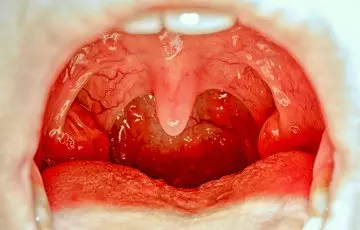Tendon Popping Out? Here’s What It Means

Image: Shutterstock
Have you heard of evolution? Yes, I am talking about that thing which made an ape into a man (not that I find much difference between the two, but Science does). In this process, the organs that have no use have been entirely eliminated from the species.
Before I say anything, follow these steps and find out if you have this tendon or not.
- Place your palms on a surface such that the palm faces the roof. Something like this:
- Now, join your thumb and little finger together and slightly press.
- Gently flex the palm.
- If you have the muscle called Palmaris Longus in your forearm, you should be observing a slight bump or fold on the wrist. If there’s no fold, this means the muscle is absent.
- Final Step: Don’t forget to comment in the section below and tell me whether you have this fold or not.
One of the typical examples given to explain this phenomenon is that the giraffe developed such a long neck slowly over many generations because it had to crane its neck to reach out to the tall trees to graze on them. The giraffe used the neck, so it developed. Similarly, we (human beings) don’t use the muscle #1 Palmaris Longus anymore for holding on to things or for gripping, and hence, it is slowly disappearing. Almost 14% (approximately) of the population doesn’t have this muscle. The fold that is seen on the wrist is essentially the tendon that is joining this muscle to another bone in the wrist.
That was about the Use and Disuse of organs and how they evolve when used and get extinct when disused.
So, let’s talk about #2 Goosebumps next, shall we? Like organs, even behaviors and traits also follow the same Use and Disuse strategy. Goosebumps are reactions to stress. Their primary function is to trap the heat amidst the hair follicles and keep you warm and also to make you look bulkier than you are to defend yourself from the predator. However, neither of the reasons are relevant today because we aren’t naked apes where we require erected hair to protect us neither do we need to look huge to save ourselves from a predator. This bunch of traits and organs that are “evolutionary residues” are called vestigial features. Go ahead and read about the other vestigial parts of the human body.
#3 Appendix
The appendix is another part of the human body that doesn’t serve any purpose, at least not that the scientists know of. When there’s a block in the appendix, there’s inflammation, obstruction to the flow of blood, and there’s increased pressure inside this tube-like organ, leading to appendicitis (1). If the block isn’t removed, it could lead to a more complicated spreading of infection when the appendix bursts due to the increased pressure. Even after the appendix is removed surgically in such cases of appendicitis, people don’t complain of any loss or impairment as such, and hence the appendix is considered to be just an evolutionary remnant. It was earlier a part of the cecum of herbivore animals that aided in digesting their food. However, those animals are now extinct. Some scientists argue that the appendix cannot be rendered vestigial because it acts as a warehouse that stores beneficial bacteria that the gut is replenished with after something like diarrhea that just removes all the good bacteria from the gut. Well, sounds contemporary and new. Wonder what’s true, though!
#4 Tonsils
There’s a dichotomy when it comes to tonsils. Whether tonsils are vestigial or not is still a debatable topic. Why some people claim they are not vestigial is that these structures help in immunity and in curbing infection. They trap the harmful foreign particles that are inhaled and travel through the air passage. When something is serving such an important function, it can’t be called entirely unnecessary, right? But, there’s another set of people that say if it is really serving a purpose and is essential to the human body, how is the body functioning equally well even in people who have got their tonsils removed. Also, these structures, in the process of inhibiting the infection, get inflamed and cause a lot of inconvenience to the body sometimes. Both the lines of thought sound convincing. What a fix!
#5 Wisdom Teeth
Remember our forefathers? They didn’t feed on Ricotta and Cottage Cheese Lasagna. They ate raw food and hunted to eat meat. That was why they required an extra pair of molars. The texture of the food they ate, like nuts and leaves or even roots, were rough and needed quite a bit of chewing, for which they required a little too many teeth. Over the years, human jaws have shrunk, and they now find it difficult to accommodate so many teeth. This wisdom teeth often cause discomfort when they partially grow or grow more in number than usual. If the wisdom teeth/tooth cause(s) any pain or paves a way to infections or other complication, you jolly well just get it/them removed. However, the best time to remove it is when the tooth has grown 2/3rd in length from the root.
#6 Little Toe
The little toe is considered vestigial too. Why? We don’t need it anymore. Of course, it might look funny to paint just four nails while you were used to painting five of them all the time. Though, the truth is that the little toe doesn’t help in maintaining balance while walking. Our toes are designed in such a way that they offer us balance while we walk. In this scenario, the little toe plays little role. We can walk perfectly well and balance ourselves just the way we do now even without the little toe.
Science is full of battles. Until the Italian dude Galileo entered the scene, no one knew the sun was the center of the solar system and comfortably believed that our solar system was geocentric. Of course, he was disregarded and accused of blasphemy, probably the cost he needed to pay to reveal the truth. And like it is said, “Those also serve who stand and wait,” probably these organs that are labeled vestigial must be having a significant function, indeed. Who knows? Until the next Galileo comes…





























